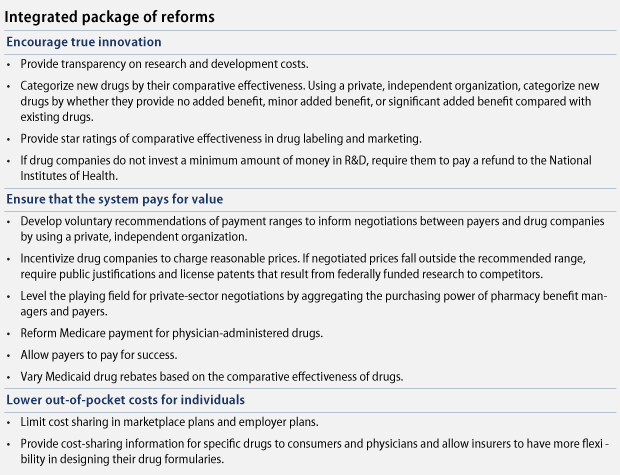In any given month, about half of all Americans—and 90 percent of seniors—take a prescription drug. These medications help millions of patients fight illnesses and recover from injuries; they also shorten the duration of common illnesses, alleviate pain, and treat life-threatening illnesses. Simply put, prescription drugs save lives and can prevent costlier, more invasive treatments.
Yet not all drugs offer the same value, and too often, patients and insurers pay exorbitant prices for their medications, even for products that are no more effective than cheaper options. In 2014, more than half a million Americans took at least $50,000 worth of prescription drugs each. Americans pay out of pocket for a much greater share of prescription drug costs than hospital costs. Not surprisingly, almost three-quarters of the public thinks that drug costs are too high. And while drug prices keep going up, a significant percentage of new prescription drugs are designed to treat the same conditions and offer little clinical advantage over existing drugs.
Spending on prescription drugs is now growing at a faster rate than spending on any other health care item or service. Furthermore, drug prices are rising at a rapid enough rate that they are affecting the overall rate of health care cost growth. For example, Medicare’s costs per beneficiary increased by 2.3 percent during 2014, after two years of no growth, due in large part to the almost 11 percent increase in drug costs for the program.
There are numerous reasons why patients and health care payers pay such exorbitant prices for prescription drugs. Unlike other nations, the United States does not directly regulate the prices that drug companies can charge for their products. In addition, patent protection and market exclusivity shield drug manufacturers from normal market competition, giving manufacturers significantly greater bargaining power than insurers. Without any competition or additional regulation of prices, the price is simply what the manufacturer sets for its monopoly product.
All consumers end up paying more for health care because of these high prices. Patients in need of expensive medications often will pay thousands of dollars per month. But it is not just patients who need these products who help pay these costs. Rising drug costs also increase premiums and cost sharing for all consumers. These costs also will continue to squeeze federal and state budgets as Medicare, Medicaid, and other health care programs pay for these treatments. At the same time, drug company profits continue to increase at a faster pace than any other sector of the health care industry.
This growing crisis is not sustainable. In a previous report, the Center for American Progress recommended several policies that the nonpartisan Congressional Budget Office, or CBO, estimates would reduce federal spending on drugs by more than $140 billion over 10 years. The focus of this report is a package of new, additional ideas that will:
- Lower drug costs across the board
- Ensure that relative drug prices reflect the benefits to patients
- Address drug costs paid for by both public programs and private insurance
The table on the following page summarizes the proposed package.
Together, these reforms will broaden the impact of research, lower costs for prescription drugs throughout the system, and offer greater financial protection for those Americans whose lives and health depend on prescription medications.

Topher Spiro is the Vice President for Health Policy at the Center for American Progress. Maura Calsyn is the Director of Health Policy at the Center. Thomas Huelskoetter is the Research Assistant for Health Policy at the Center.